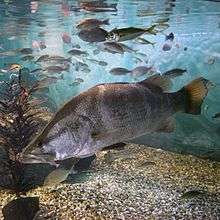Japanese lates
| Japanese lates | |
|---|---|
 | |
| Japanese lates at Himeji Aquarium | |
| Not evaluated (IUCN 3.1) | |
| Scientific classification | |
| Kingdom: | Animalia |
| Phylum: | Chordata |
| Class: | Actinopterygii |
| Order: | Perciformes |
| Family: | Latidae |
| Genus: | Lates |
| Species: | L. japonicus |
| Binomial name | |
| Lates japonicus Katayama & Y. Taki, 1984 | |
| Wikimedia Commons has media related to Lates japonicus. |
The Japanese lates (Lates japonicus), also known as the akame (from the Japanese 赤目, アカメ, literally "red eye") or Japanese barramundi, is a rare and shy fish endemic to Japan. It has a comparatively long and compressed body and a large mouth. It is a metallic grey in overall colour, with a bluish tint, darker upperparts, and lighter underparts. Its fins are greyish black, and its pupils are red.[1] The Japanese lates was first scientifically described in 1984, having previously been considered the same species as the barramundi (L. calcarifer). Even when it was realised it was a separate species, publication of a formal description was delayed since the type specimen of the barramundi was alleged to originate in Japan, and because of confusion caused by the deformities of the barramundi's type specimen.[1] The Japanese lates differs from the barramundi in several features. It has a deeper body, longer third dorsal and second anal spines, fewer pectoral fin rays, more scales, and fewer gill rakers.[1] It reaches a maximum length of 130 centimetres (51 in) and a maximum weight of 33 kilograms (73 lb).[2]
The Japanese lates is a bottom dweller in the freshwater shallows, estuaries, and the ocean.[2] The Japanese lates is known in the south-western part of the Japanese main islands, where it is found in the seas around Tosa Bay, in Kōchi Prefecture, Shikoku and near Miyazaki City in Miyazaki Prefecture, Kyushu. It is believed to spawn there, and younger fish are found up the Ohyodo and Shimanto rivers. The barramundi is believed to replace it in the Ryukyu Islands.[1][3]
The Japanese lates has long been known to fishermen, but because of its relative rarity and shyness, it achieved "almost legendary" status.[4] The Japanese common name, akame, means "red eyes".[1] For some time, scientists were uncertain which fish was the "akame" of legend, and some suspected Psammoperca waigiensis.[1] It is kept in aquaria and cultured for food,[2] but is poorly known in the wild. In February 2010, the first video of the akame living in its natural surroundings was broadcast on the BBC, in a report on the University of Tokyo's research project where akame are fitted with ultrasound tracking devices.[4][5]
References
- 1 2 3 4 5 6 Katayama, Masao; Taki, Yasuhiko (1984). "Lates japonicus, a New Centropomid Fish from Japan" (PDF). Japanese Journal of Ichthyology.
- 1 2 3 Froese, Rainer and Pauly, Daniel, eds. (2010). "Lates japonicus" in FishBase. February 2010 version.
- ↑ Iwatsuki, Y.; Tashiro, K.; Hamasaki, T. (1993). "Distribution and fluctuations in occurrence of a Japanese centropomid fish, Lates japonicus" (PDF). Japanese Journal of Ichthyology. 40 (3): 327–332.
- 1 2 "Japanese scientists uncover rare Akame fish behaviour". BBC News. 23 February 2010. Retrieved 23 February 2010.
- ↑ Tanoue, H.; Komatsu, T.; Tsujino, T.; Suzuki, I.; Watanabe, M.; Goto, H.; Miyazaki, N (2012). "Feeding events of Japanese lates Lates japonicus detected by a high-speed video camera and three-axis micro-acceleration data-logger". Fish. Sci. 78 (3): 533–538. doi:10.1007/s12562-012-0470-z.